Do I Have to a Good Tank for My Baby Savannah Monitor
Many pet store and reptile testify visitors often see savannah monitors, or Varanus exanthematicus.
Naturally, their cute faces and pocket-size size equally hatchlings pique the curiosity of reptile lovers.
Due to their size and dietary requirements, savannah monitors are considered an intermediate species – better suited to someone who's already had experience and success with other lizards, like bearded dragons or geckos.
They're certainly NOT ideal for anyone short on space or time.
What Y'all'll Learn In This Savannah Monitor Care Canvas:
- Background information on savannah monitors
- Where to buy a healthy savannah monitor
- Relative cost of a savannah monitor
- Proper diet for all ages
- How to properly set up a savannah monitor enclosure
- Health concerns to be aware of (plus how to prevent them!)
- Treatment & bonding tips
- & So much more!
A 5-foot lizard simply won't fit inside most commercial aquariums, let alone thrive!
And no ane wants to deal with an animal of such size and forcefulness that hasn't received the attention and time needed to make information technology tame and condom to care for in captivity.
Fortunately, savannah monitors make groovy, intelligent, and even affectionate pets for those who can provide the required effort AND investment.
Whether you're wondering if a savannah monitor is the right monitor for you OR you've already succumbed to the sugariness confront of a hatchling and fabricated your purchase, read below to learn all you demand to know (and then some!) to raise a happy and healthy savannah monitor!
Savannah Monitor Background Information
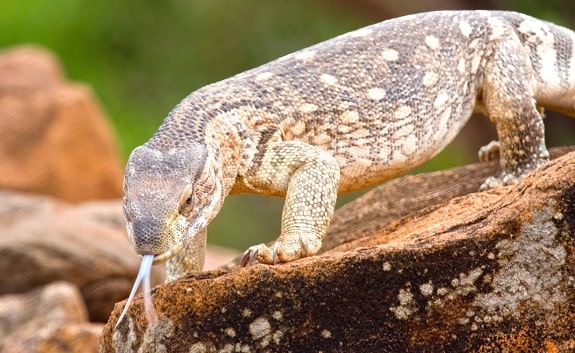
Like their namesake, savannah monitors are native to the savannas and grasslands of primal Africa. Their preferred natural habitat is thin, dry, and desolate, but they also inhabit open forests, rocky areas, and woodlands.
These lizards are various shades of tan, brown, and greyness with pale spots over their back. Beingness basis-dwellers, savannah monitors are stocky and stout compared to their arboreal and aquatic cousins.
Their cervix and tail are short compared to other monitors. Meanwhile, their limbs and head are more than squared and muscular to help them dig.
Savannah monitors make popular pets due to their intelligence and friendly nature. Still, they exercise crave time and try to tame and train.
In an appropriately sized enclosure with adept husbandry, you tin can look your pet savannah monitor to be your companion for the next x to xv years.
| Quick Facts at a Glance: | |
|---|---|
| Common proper name | Savannah Monitor |
| Scientific name | Varanus exanthematicus |
| Adult size | 48-60 inches |
| Price | $20-$40 |
| Lifespan | fifteen years |
| Nutrition | Insects and other invertebrates |
| Tank Size | 6' Long x 5' Broad ten 4' Tall |
| Temperature & Humidity | Basking spot: 100-130°F, Warm Side: 85-88°F, Cool side: 75-80°F, Humidity: 40-sixty% |
| Popular alternatives | Ackie Monitor , Asian Water Monitor |
The Basics – Where to Buy a Savannah Monitor
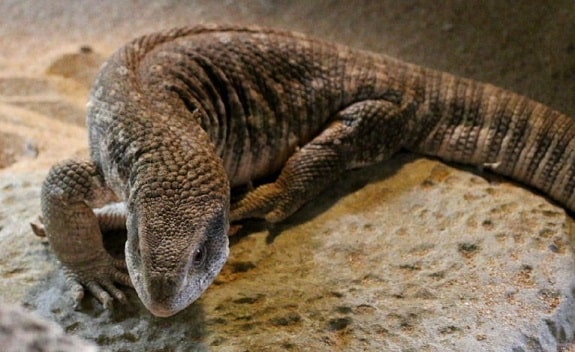
Before you make your purchase, y'all should try to decide whether you want a captive-built-in or wild-caught savannah monitor. Nearly wild-defenseless savannah monitors are even so babies, so they're all the same easily tamed.
Wild-defenseless lizards may be more than affordable… but they tend to likewise carry more parasites and diseases.
In contrast, captive-born individuals are typically healthier, but they can cost more. You should ALSO consider the ethical bear upon of purchasing an animal that was removed from the wild.
A third option exists, known as captive-farmed. Captive-farmed ways that the animal was bred in captivity on a large-scale farm in its country of origin and shipped to the United States.
A baby savannah monitor will cost you $xx to $40, depending on the seller and the source of the animate being. Adult individuals of pet or breeding quality usually cost more.
🔑 Savannah Monitor Purchasing Central Takeaways: Those looking to buy a savannah monitor will essentially have 3 choice: wild- caught, captive-built-in, or captive-farmed. The MOST ethical of the three will certainly be captive-born, specially when doing business with a responsible and reputable private breeder. This will also be your best bet at acquiring a healthy pet. Expect to spend anywhere from $xx to $forty on boilerplate for a baby.
Savannah Monitor Nutrition & Feeding
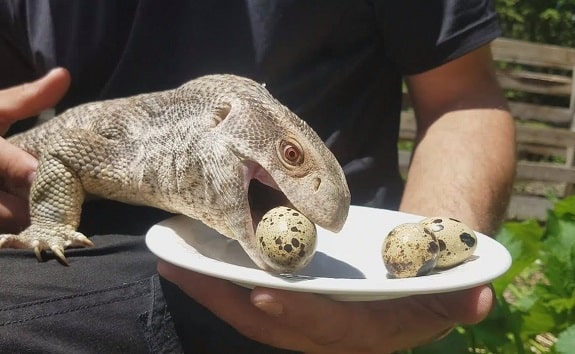
The majority – at least 75% – of your savannah monitor's diet should consist of a variety of insects and other invertebrates .
With the remaining 25%, yous can offer variation in the form of rodents, eggs, chicks, meat, or commercial foods.
If you still find your pet becoming chubby, cut dorsum on the corporeality of nutrient and the frequency of feedings. Savannah monitors should be slim and muscular, WITHOUT hip basic or ribs showing.
As you might expect, feeding a giant lizard enough insects to sustain it, sometimes daily, can go quite plush. It can likewise become inconvenient if you don't savour frequent trips to the pet store.
Near monitor keepers terminate upwardly finding that it is much more affordable to brood their colony of feeder insects to use as the base diet.
Every bit a bonus, you will know that your reptile's nutrient was raised healthfully and humanely.
Use tongs or a bowl to offering the food to your savannah monitor. Hand feeding can cause your pet to mistake your fingers for food, which volition lead to bites.
The substrate in the enclosure may pose an impaction run a risk, so some keepers opt to feed their savannah monitor in a pocket-sized, blank-bottomed tub.
What their Nutrition Consists of:
- Insects: Crickets, waxworms*, mealworms, earthworms, super worms*, silkworms, grasshoppers, roaches, canned insects
- Rodents: Mice*
- Other: Ground turkey, crayfish, canned dog food, commercial monitor food, fish, egg whites, chicken giblets, chicks, ducklings
- Vitamins and supplements: Dust insects, pinky rodents, and meat with calcium powder. Gut-load insects by feeding them fresh vegetables and fruits, or a specially formulated commercial "insect gut load" made with vitamins and nutrients. For further peace of mind, you can also provide a commercial reptile multivitamin once or twice a week.
*These food items are high in fat. Every bit such, you should cut back on them or finish offer them altogether if your savannah monitor is overweight.
How Diet Varies By Age
In the wild, baby and juvenile savannah monitors eat mostly grasshoppers, crickets, and similar insects. Developed savannah monitors eat mostly millipedes, beetles, and insect larvae.
You tin practise your best to try to imitate this natural dietary graduation in captivity.
Besides the deviation in insect types, juveniles and adults' diets are mostly the aforementioned – carnivorous, with insects being the primary source of protein.
Withal, your savannah monitor's feeding frequency may change once they attain maturity.
Feeding Schedule: How Often to Feed to Feed Them
As with most reptiles, growing babies and juveniles will crave more than frequent feedings than adults. Run into below to become an idea of how oftentimes to feed your pet based on age…
Babe Savannah Monitor Feeding Frequency
Young and sub-developed savannah monitors should receive food five to seven times a week.
Adult Savannah Monitor Feeding Frequency
Adult savannah monitors tin can be fed as often as once a day to every bit petty equally two to three times a calendar week , depending on how much food y'all offer them and their body status.
If your pet starts to put on too much weight, get-go cutting back on how often you feed information technology.
🔑 Savannah Monitor Nutrition Key Takeaways: As obligate carnivores, the bulk of a savannah monitor'due south diet (at any age) volition consist of primarily of poly peptide. The majority of this protein should come from insects and invertebrates, such every bit crickets, mealworms, earthworms, roaches, grasshoppers, and the like. Many owners will find it more affordable to brood their own insects. When it comes to feeding frequency, babies and juveniles will need to eat at least 5 times a week, whereas adults tin be fed two-3X a week. Because obesity is prevalent, weight should always be monitored.
Savannah Monitor Habitat & Enclosure Setup
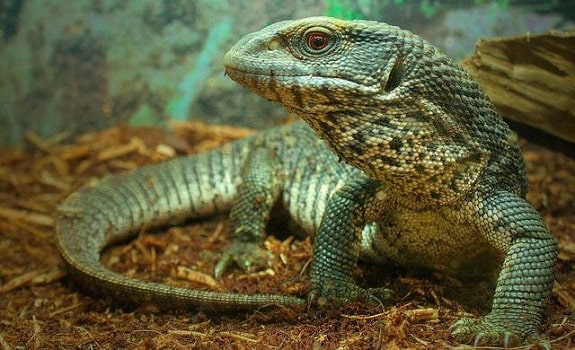
Size of the enclosure
Most owners will discover it benign to offset start with a smaller enclosure for a baby savannah monitor, and graduate to a larger enclosure once they reach maturity.
This volition brand mastering the temperature zones, humidity, and lighting setup easier.
The minimum enclosure size for a hatchling savannah monitor is 36" 10 24" x 20", whereas the minimum enclosure size for an adult savannah monitor is half dozen' x five' x 4'.
Preferably, the enclosure volition be twice as long every bit your monitor, the width of the enclosure will exist at least equal to the length of your lizard, and the tiptop will allow for a co-operative, rocks, and the ability to climb.
Since they're footing-dwelling lizards, floor space takes priority over height. Likewise, delight go on in mind; these are the minimum guidelines. Your savannah monitor will ALWAYS appreciate more space!
Type of Enclosures
Given the massive amount of space required, y'all will probably need to apply a custom-built enclosure . Commercial aquariums don't typically encounter the minimum dimensions needed for an adult savannah monitor.
Custom enclosures are synthetic from woods, plastic, glass, acrylic, wire, or a combination of them.
Since these lizards inhabit barren landscapes, the habitat volition require proper ventilation. This is easier to achieve with a wire or screen top.
You will also need to take a sufficient amount of ventilation ports installed if you opt for an entirely wood, plastic, drinking glass, or acrylic enclosure.
Any wire or screen on the enclosure needs to be resistant to your pet's claws.
Ideal Temperatures and Lighting
Savannah monitors are pretty hardy when it comes to temperature fluctuations. Nonetheless, they do require high temperatures to assimilate their food and thermoregulate.
The basking area should accomplish 100°F to 130°F. This doesn't hateful that the whole enclosure or even half of the enclosure should be this hot. A basking spot can be achieved by placing a co-operative or rock a few inches underneath a estrus lamp – this will allow your savannah monitor to climb upwards and bask if he wants without physically touching the oestrus source and burning himself.
Information technology'due south nonetheless not universally agreed upon whether or non savannah monitors crave UVB lighting. Many keepers claim that their monitors receive all of the Vitamin D3 that they need from a healthy diet.
Still, but like with us, UVB rays may offer a wide array of health benefits, so at that place is no harm using a UVB bulb equally one of your pet's estrus sources.
The UVB lite should but be left on for ten to twelve hours a day.
Solid materials like drinking glass and plastic block UV wavelengths, so it's best to keep the lite fixture inside the enclosure or over a screen summit. Replace the UVB bulb every six months. Even if it still emits low-cal and rut, the UV output volition diminish.
The cool side should stay around 75°F-lxxx°F, whereas nighttime temperatures should dip below 72°F. If they do, you should consider adding an under tank heating pad, cable, or record, which can additionally assist in maintaining an ambience temperature of 85°F-88°F on the warm side.
Simply, what if you tin't or don't want to use a heating chemical element under the enclosure? No problem!
Ceramic heat emitters (CHE) and radiant rut panels are good alternatives that tin remain powered on xx-four hours a day WITHOUT disrupting your savannah monitor's day/night cycle.
In fact, CHEs are actually the MOST recommended heating chemical element by lifelong owners due to how safe and reliable they are.
All heating elements should exist set up with a thermostat to ensure that nothing gets dangerously hot.
Periodically monitor the temperature of the basking spot, the warm side, and the cool side of the enclosure with an infrared thermometer.
Ideal Humidity Level
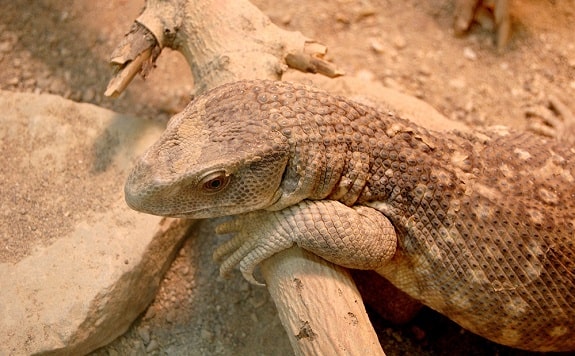
Always provide your savannah monitor with a large, non-porous water dish full of fresh h2o. It volition drinkable from it every day, and it may even soak if you provide a big enough dish.
Supervene upon your lizard's water every day, and make clean the bowl with lather and water every week.
High ambience humidity isn't required, given their native habitat. If your home'south humidity is specially low, you may want to consider misting your savannah monitor's enclosure daily.
Ideal humidity is betwixt twoscore% and threescore%. Use a hygrometer in the enclosure to ensure that these levels are maintained.
In the wild, savannah monitors will couch deep into the ground to build moist burrows. You can replicate those burrows by supplying a deep layer of substrate. When you moisten it, the top layer volition dry out chop-chop, simply the bottom layer volition stay clammy. Your savannah monitor will be able to dig downward and reach this humid environment if he feels the need.
Alternatively, y'all tin provide a humid hide or cave with damp sphagnum moss.
Sufficient access to humidity and moisture volition help to facilitate your savannah monitor'due south shedding . Shedding occurs every four to half dozen weeks, or more than ofttimes for growing hatchlings. Onetime pare comes off in large patches.
Substrate
As mentioned before, savannah monitors L-O-V-East to dig! Information technology offers an excellent source of practise, enrichment, and the ability for your pet to regulate the level of humidity she'southward exposed to.
The BEST substrates that let your lizard to exhibit their natural burrowing tendencies are loose and calorie-free. The ideal substrate depth is one to two feet.
Some examples of bully burrowing substrate include:
- Cypress mulch
- Organic potting soil
- Kokosnoot fiber
- Reptile-safety sand
Unfortunately, loose substrate has a history of causing an impaction if your savannah monitor accidentally ingests it with its nutrient.
If you lot prefer NOT to utilize loose particle substrate, you tin can use:
- Newspaper
- Butcher block paper
- Outdoor carpeting
If yous go the route of a solid, not-particle based substrate, you'll need to utilize numerous, adequately-sized caves, hides, and branches to replace the do and enrichment opportunities that loose substrate would provide. Hide boxes need to be large plenty for your savannah monitor to turn effectually in.
A humid hide can be engineered by placing damp sphagnum moss nether a cave or covering on the warm side of the enclosure.
A dig box would also be beneficial. Ensure that it's large enough for your savannah monitor to turn effectually in, and the soil should be one to two feet deep.
Decor and Accessories
Information technology can exist challenging to find caves and hides large enough for adult savannah monitors…
When it comes to creating a DIY hide or cave, many people opt to use a thin piece of plywood propped up on a rock or a couch dug out underneath where it is lying flat. Cardboard boxes or plastic dishpans and litter boxes with holes cut out are likewise practical.
If yous prefer a more natural await, you might be able to find and purchase large pieces of cork bawl in a reptile shop or online.
Make certain to provide an opportunity for your savannah monitor to climb and bask within a few inches of your UV heat lite, WITHOUT beingness able to touch on it and burn itself.
You lot can employ a big rock or a co-operative, or both for a basking spot.
Rocks have the added do good of helping to keep your lizard's nails filed down, only they should exist relatively smooth and costless of abrupt edges for safety purposes.
🔑 Savannah Monitor Enclosure Key Takeaways: Due to their big size, savannah monitors require adequately large cages of at least 36" x 24" x 20" for hatchlings and vi' x five' ten 4'. Custom built cages are typically your all-time bet. For temperatures, you MUST accept a basking spot between 100-130°F, and humidity levels should be between 40-50%. At night, if temps drop below 72°F you lot should provide an additional rut source. Loose particle based substrate are great for digging, but solid substrates will best prevent against impaction. All enclosures should include accessories such as hides/caves, branches, rocks, etc.
Savannah Monitor Full general Wellness Information
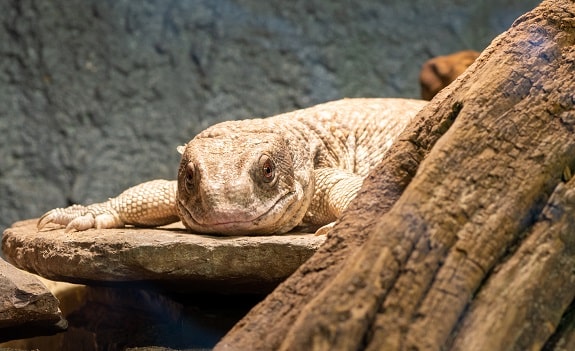
Obesity and Fat Liver Disease
The Virtually mutual health complexity that savannah monitors face is obesity and associated fat liver disease.
Since they are opportunistic predators and fifty-fifty scavengers, they volition likely consume everything that you offer them. If you notice that your pet is packing on the pounds, feed them less often, offering less fatty food, and give them more than opportunities to do – inside and outside of their enclosure.
An obese savannah monitor will NOT live a long life.
Nutritional Secondary Hyperparathyroidism or Metabolic Bone Illness
This disease is common amid lizards and other reptiles that receive an improper nutrition.
Most feeder insects have a loftier phosphorus to calcium ratio, so reptiles' food needs to be dusted with calcium powder to avoid metabolic bone disease. UVB lighting too assists in preventing this unfortunate affliction.
Symptoms of Metabolic Bone Disease in Savannah Monitors Include…
- Deformed bones
- Bowing legs
- Shortening of the face
- Weakness
- Anorexia
- Stunted growth
Unremarkably, the state of affairs can be resolved over fourth dimension with husbandry comeback and increased calcium supplementation. This is especially truthful if defenseless early.
Burns
Unfortunately Burns are common… but they are 100% preventable!
Simply run your heating elements on a thermostat and keeping overhead heating elements out of reach from your savannah monitor.
Reptile oestrus rocks are also Non platonic, due to the burn down chance that they pose.
External and Internal Parasites
Wild-caught and captive-farmed savannah monitors will likely take some degree of parasite load. Unfortunately, many commercially purchased feeder insects Besides deport internal parasites.
If your pet starts to show the following signs of existence sick, have them to the vet ASAP:
- Lethargy
- Abnormal stools
- Loss of appetite
- Vomiting
🔑 Savannah Monitor General Health Key Takeaways: Just like all animals, savannah monitors are decumbent to their fair share of wellness concerns, especially obesity and fatty liver disease. However, y'all can nigh eliminate their risk of this (also as both metabolic bone disease AND parasites) by closely monitoring their diet, calcium intake, providing UVB, and convenance your own colony of feeder insects.
Savannah Monitor Handling & Bonding
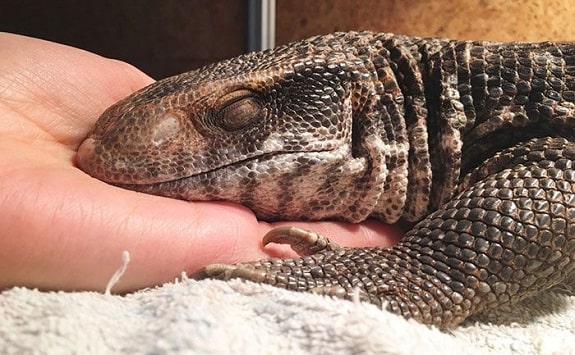
Out of all of the monitor species, savannah monitors are the mildest mannered. However, any animal with a oral fissure and teeth can bite, and an creature of this size is capable of delivering a painful bite, scratch, and tail-whip.
Baby savannah monitors may exist specially flighty AND defensive due to their small size.
Over time, your pet will become accepted to your appearance and your odour. Information technology volition larn to trust you, and you volition larn to trust information technology. Providing additional enrichment can offer fifty-fifty more opportunities for bonding.
Daily contact and handling are required. Avoid sudden movements, just move with confidence. When belongings your savannah monitor, provide back up under their chest and hind limbs. Being terrestrial, they're most comfortable when they feel a surface underneath their feet.
Although you should be comfy handling your monitor, there will naturally be times where they practise NOT want to be held or bothered.
Some obvious signs that your savannah monitor is Not in the mood for handling include…
- Hissing
- Snapping
- Opening its oral fissure
- Enlarging its throat
- Standing on its hind legs
- Whipping its tail
Any further harassment will likely event in a seize with teeth, so you should Simply proceed if you lot have reptile treatment experience, and you lot are attempting to tame a particularly spunky private.
Keeping your savannah monitor'south nails trimmed volition lessen the frequency and severity of accidental and intentional injuries.
Smash trimming is a two-person job and, again, requires feel in the restraint of reptiles.
One pro to owning a monitor is that dissimilar other reptiles like snakes that don't show beloved , savannah monitors have been known to display signs of affection towards humans they've bonded with!
This is specially truthful amongst monitors whose owners take the time to create extra enrichment for them to bond over together.
To provide extra enrichment for your monitor you can
- Alter Wiffle balls to hold freeze-dried or canned insects for them to play with
- Sprinkle different spices and new substrates for them to aroma
- Hibernate pieces of food under pieces of terrarium piece of furniture
- Provide weekly outdoor swimming sessions in a big kiddie pool for extra exercise and UVB
🔑 Savannah Monitor Handling & Bonding Key Takeaways: Savannah monitors volition need to be handled regularly for taming and grooming purposes. With time, you should expect a well cared for monitor to trust yous and even show signs of affection. However, there will exist instances in which your monitor may human activity aggressive (such as through hissing) in which yous will want to back off. It takes time and patience to develop a bond, but once solidified, that bail is difficult to intermission.
But e'er recall that non all monitors make pleasant visitor. For example, crocodile monitors are notorious for beingness unsafe and unpredictable.
Is a Savannah Monitor Correct for Y'all?
Savannah monitors may non brand a great starting time reptile or fifty-fifty first cadger for beginners .
All the same, if you lot've already got some feel under your belt, these interactive "lilliputian" guys can make the perfect pick for your offset pet monitor.
Their size, enclosure requirements, and diets exceed the difficulty of care required by other beginner lizards – like bearded dragons and leopard geckos.
And they're not exactly an ideal fit if you're low on space, depression on fourth dimension, or uncertain about handling giant lizards.
Yet, savannah monitors do, offer an excellent opportunity to experience the level of zipper and intelligence that other monitor keepers experience in a smaller, more affordable, more than manageable package.
If you've got the fourth dimension, coin, infinite, patience, and previous feel with reptiles, await to fall in love with the savannah monitor!
Source: https://reptile.guide/savannah-monitor-care/
0 Response to "Do I Have to a Good Tank for My Baby Savannah Monitor"
Post a Comment